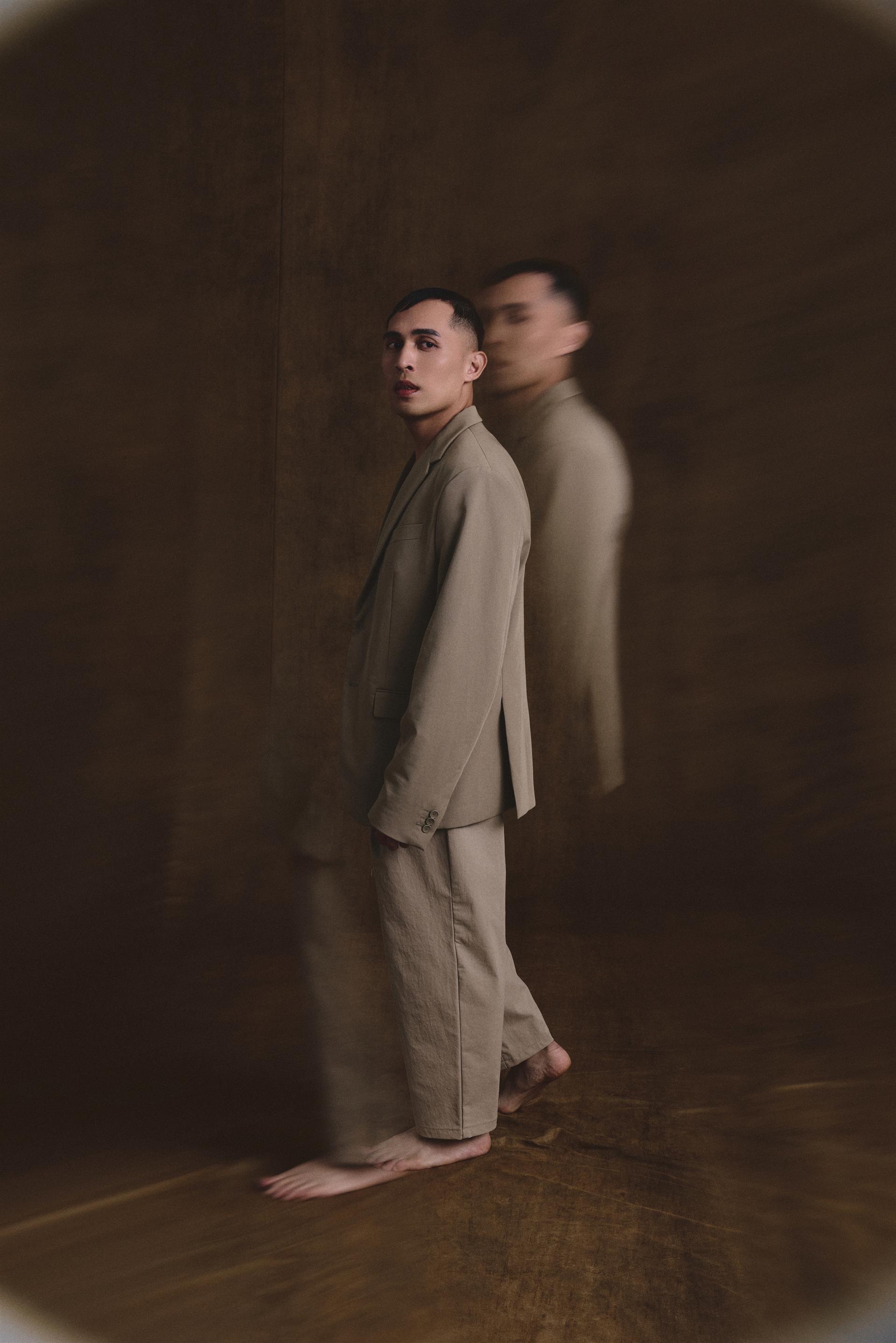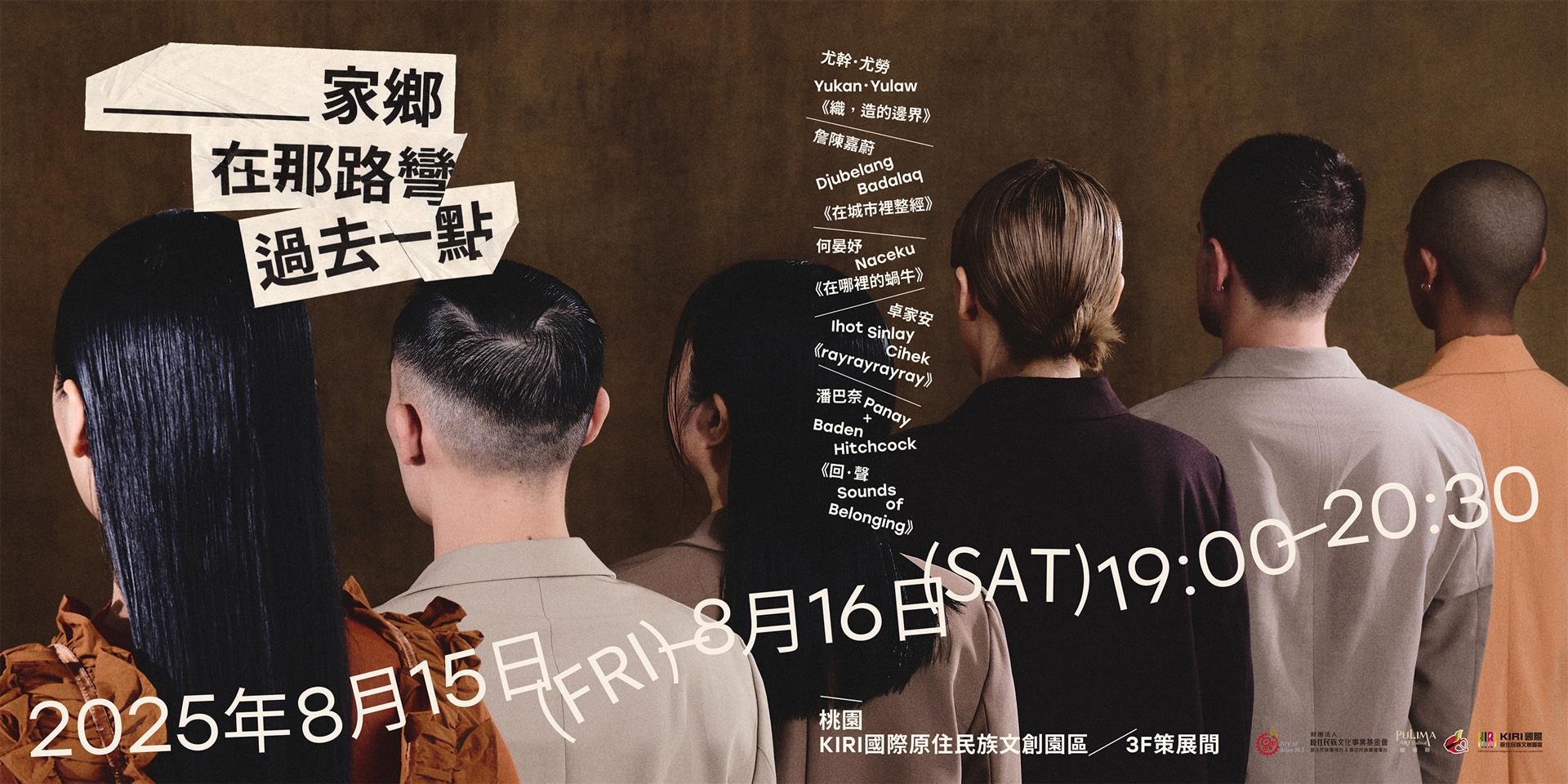創作者介紹|在編織縫隙裡,看見一位自己的形狀
來自 Mstranan Ulay(新北烏來部落)的泰雅族創作者,1985年生。現任新北市立德拉楠民族實驗小學教師,長年深耕原民教育現場。作為家中長子,他的生命經驗緊繫著文化、責任與傳承,也在成長過程中逐步開啟對空間與視覺的敏銳感知。Yukan 起初未將「藝術」視為創作之道,直到研究所畢業後,逐漸發現藝術不只是表現形式,更是一種回望文化、探問認同的方式。自2019年起,他陸續參與朋友、部落協會與公部門的展覽規劃與佈展,並於2020年正式踏入創作領域。首件作品以現成物與空間裝置,回應原住民青年認同的流動與斷裂;2021年發展帆布編織,觀察並呈現部落日常;2022年進一步融合影像與薯榔染,以家人的生命經驗為核心,探討自我認同的形塑與族群敘事的延續。他的創作既來自個人生命史,也源於對部落當代處境的細膩觀察。Yukan不斷在展覽與創作中摸索屬於自己的藝術語彙,將空間視為敘事載體,透過材料、裝置與編織技法轉化記憶與身份議題。他的作品常以安靜卻具穿透力的方式,與觀者分享原民青年的現實處境與文化思考。Yukan相信展覽空間不只是展示的場域,而是一種說故事的方法。他持續實踐「如何成為一位當代原住民」的提問,並透過藝術建立與族群文化間更深刻的對話關係。
節目名稱|《織,造的邊界》
本裝置作品以「織造」作為核心的創作語彙,透過對藍白帆布的解構與再構築,探討多重層次的「邊界」概念。看似日常且樸實的藍白帆布,在解構與編織的過程中,被賦予了全新的生命與意義,如同我們在既有的框架與界線中,尋找突破與對話的可能性。整體而言,「織造的邊界」試圖透過藍白帆布的轉化與重塑,呈現不同層次邊界的存在與消融。從地理的流動、性別的隱形界線,到個體間的對話與連結,作品邀請觀者一同思考在既有的框架之外,如何透過連結、理解與共創,尋找新的可能性,編織出更具包容與開放的世界。
這三件裝置作品看似承襲了泰雅族某種織藝手法,但使用的媒材跳脫出部落織人常使用的自然素材,而是使用現代部落常見的藍白帆布。
第一部分的作品《流動的織網》,將藍白帆布拆解為纖維與布條,再以鬆散而延展的方式重新編織成巨大的網狀結構。這片織網如同無垠的河流,其流動的形態消弭了傳統帆布的邊界,也暗示了地理疆界、文化隔閡的消融。藍與白的交織,既是水流的意象,也象徵著不同個體、不同思想的匯聚與交融。觀者穿梭其間,感受織網的包容與延展,如同置身於不斷流動與變化的世界之中。
第二部分的作品則將焦點轉向細膩的編織技法,並結合現成物如燈罩與鐵架。透過繁複的織紋與材質的異質結合,作品呈現出一種內在的張力。這裡,「織造」的精細與耗時,對比於現成物的工業感與既定形式,暗示了社會加諸於個體的細微規範與無形的束縛,尤其指向性別議題中刻板印象所劃定的界線。細密的織紋彷彿無數的目光與評價,纏繞在個體的身上,探討在既有框架下,個體如何被界定與感知。
第三部分的作品《共織的畫布》,則是一個開放性的協作平台。藍白帆布在此成為一方畫布,邀請不同背景(大人、小孩)的參與者共同創作。透過綁、織、編等多元的介入方式,不同個體的痕跡與敘事層層疊加,最終形成一幅充滿對話的紋理。在這裡,「織造」不再是單純的技術,而是連結不同個體的媒介。藍白畫布上的每一道痕跡,都代表著一個聲音、一段經驗,共同編織出一張跨越地域與身份的對話網絡,消弭了個體間的隔閡,展現了共創的力量。
Artist Introduction | In the Gaps Between Threads, He Saw a Shape of Himself
Yukan Yulaw is a Tayal artist from Mstranan Ulay (Wulai, New Taipei City). Born in 1985, he currently teaches at Tranan Indigenous Experimental Elementary School in New Taipei City. Deeply committed to Indigenous education, Yukan draws from his experience as the first-born son in his family—a role imbued with cultural significance, responsibility, and the transmission of knowledge. As he grew up, Yukan gradually developed a keen sensitivity to space and visual perception.
Initially, Yukan didn't consider art as his creative path. It wasn't until after he completed graduate school that he began to view art not merely as a form of expression but as a means to reflect on culture and spark discussions about identity.
He started participating in exhibition planning and installations for friends, Indigenous associations, and public departments in 2019. By 2020, he had ventured into artistic creation. His first work used objects and spatial installations to address the contemporary recognition and fragmentation experienced by the Indigenous youth generation.
Later, in 2021, he developed woven works using blue-white canvas, which responded to the daily life of the Indigenous community. By 2022, his practice had evolved to incorporate videos and betel root dyeing. These later works centered on his family's life experiences, exploring self-identity and his community's narratives.
Yukan's creations are deeply intertwined with his life journey and his tender observations of the Indigenous community's contemporary position. Through exhibitions and his artistic practice, he continues to develop his unique visual language, weaving spaces that serve as canvases for stories. His works convey a soft tone with a firm impact. By integrating diverse materials, installations, and weaving techniques, he translates conversations of memory and identity into a distinct artistic form.
For Yukan, exhibition space has always been a space for storytelling rather than merely a site for display. He is deeply committed to and driven by the question, "How can one truly become an Indigenous person in modern society?" Through this profound intention, art becomes a conduit for vital conversations about community culture.
Program Title: Weaving the Edges of Making
His work centers on the concept of “weaving,” meticulously navigating between deconstructing and reconstructing the familiar blue-white canvas. This process allows him to explore the idea of “boundaries,” peeling back veil after veil.
Yukan provides a fresh interpretation and identity for the ubiquitous blue-white canvas. Through deconstruction and reweaving, he seeks to break free from the “ivory tower” of established patterns, aiming to foster new inspiration.
The piece Weaving the Edges of Making vividly portrays the presence and dissolution of boundaries through the transformation of this everyday object. From geographical flows and invisible lines of gender to interpersonal connections and dialogues, the work invites viewers to reflect on how we might transcend existing frameworks. It encourages us to use connection, empathy, and co-creation to imagine new possibilities—and ultimately, to weave a more inclusive and open world.
Three of these creations appear to draw inspiration from traditional Atayal weaving techniques; however, Yukan utilizes blue-white canvas instead of the natural materials commonly used by community weavers.
The first piece, Flowing Weave, deconstructs the blue-white canvas into fibers and strips, then loosely and expansively reweaves them into a massive web structure. This woven net resembles a boundless river; its fluid form washes away the canvas’s physical boundaries while metaphorically hinting at the dissolution of geographical and cultural borders. The interlacing of blue and white symbolizes currents and individuals. The web itself allows us to embrace our diversity and extension, as if we were situated in a world in flux.
The second piece shifts its focus to delicate weaving skills, combining objects such as lampshades and metal frames. This unexpected juxtaposition of intricate patterns and materials creates an inner tension. Here, the time-consuming process of weaving contrasts sharply with the industrial rigidity of the ready-made forms. This contrast subtly suggests the norms and invisible constraints society places on individuals—particularly referencing the boundaries shaped by gender stereotypes. The patterns themselves evoke countless gazes and judgments, exploring how individuals are defined and perceived within established frameworks.
The third piece, Collaborative Canvas, is conceived as an open platform for collective creation. The blue-white canvas serves as a shared space, inviting participants of all ages and backgrounds to create together. Through binding, weaving, and various forms of engagement, traces and narratives from multiple individuals layer upon one another to form a textured dialogue.
Here, weaving transforms into more than just a skill; it becomes a medium for connection. Every mark on the canvas represents a voice, a life experience, interlaced into a network of conversation that extends beyond geography and identity. This work celebrates co-creation and actively dissolves the boundaries between individuals through shared expression.
延伸閱讀:
➤ 專訪|尤幹.尤勞 Yukan.Yulaw



